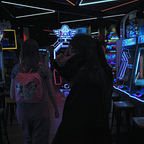Hyperrealism, Artist Practice, And Material Usage: Duane Hanson & Patricia Piccinini
Through the use of hyper-realistic sculptures, both Duane Hanson and Patricia Piccinini explore grotesque exaggerations of the absurd and the mundane in their work. Their material use enables them to communicate unique ideas and intentions regarding human nature and relationships.
Patricia Piccinini is a Sierra-Leonean contemporary sculptor currently living and working in Australia. Her work explores notions of the interconnection of the natural and artificial, and thus human nature as a whole.
Her pieces as a whole rest in a space of ambiguity, her hyper-realistic style is used to explore absurd themes, thus forcing audiences to question not only her work, but its relation to the world around us.
Her combined use of artificial materials, such as silicone and fibreglass, coupled with her use of organic materials such as human hair, creates an eerie sense of interconnection between the living and synthetic, thus communicating to the audience’s ideas of the imminent merge of technology and human life.
Within Doubting Thomas, 2008, Piccinini explores the increasingly blurred boundaries of human life and technology through the imagery of a young boy, petting a mutated, mole-like creature, giving birth, sat upon a chair in front of him. Through the casual costuming of the boy, Piccinini creates a direct connection between art and audience, bringing the boy into the realm of relatability.
The use of human hair furthers this connection, making the boy seem eerily real for audiences viewing him. The young boy comfortably reaches towards the creature, which appears to be giving birth, and through this posing, Piccinini alludes to the innate curiosity humans hold for other living beings. The boy is not afraid nor alarmed by its presence, instead, he holds an innocent and inquisitive gaze, showcasing the natural empathy humans are born with, and how our fear of the unknown is taught to us as we age.
The use of silicone on the creature, as well as a light layer of fur, gives an organic sense to it, despite its surreal and mutated form. As well as this, as her pieces rely on digitised techniques to express and then create her ideas, she further makes commentary on the intertwine of the natural and artificial world. Thus, Piccinini’s material use is her vehicle to communicate the interconnected and changing nature of our world.
Duane Hanson was an American sculptor, whose work primarily focused on surrealist, hyperrealistic sculpture of middle-class American citizens.
Hanson’s work dealt with the unknown that lies within the ordinary and every-day. The sculptures, in a hyperrealist style, often held solemn and melancholic expressions, amplified by the hyper-real features presented. Thus, creating an uncomfortable experience for audiences, who were able to get as close as possible to each piece, enabled them to view every last detail.
His pieces underwent a complex, six-month creation process. As seen in Young Shopper (Chelsea location), 1973, Hanson would begin this process with a live model casting. Through the casting of a live model, Hansen was able to make the bodies of his sculptures incredibly life-like, and almost unsettling for viewers.
After finding a model whose body he wanted to replicate for his piece, he would apply a fast-setting silicone rubber to their body to create a mould, then would pour liquid polyester resin reinforced with fibreglass into the mould. He would often reuse the same model he had created multiple times, changing their head, pose, setting and skin tone to suit his intentions.
Young Shopper (Chelsea location), 1973, illustrates this, as well as his use of real clothes and props such as shopping bags and purses. This use of real clothing, similarly to Patricia Piccinini, creates a sense of uncomfortable relatability for the audience. It further brings the subject into the world of the viewer.
In turn, creating grotesque and absurd representations of the hyper-consumption seen within capitalistic societies, as illustrated by the figure’s struggle to carry all of their shopping, in conjunction with the mundane situations in his work.
Hanson utilized acrylic, and then oil paint on top to create his skin tones. This layering creates a slight, uncomfortable contrast for viewers, as the body shape is extremely realistic, but the skin tone cannot come close to anything of real life. Thus, Hanson’s meticulous and detail-driven process and material usage enable him to create pieces that illustrate the mundane in ways that can distress and intrigue audiences.
Material use is integral to an artist’s ability to communicate their ideas and intentions to audiences. Patricia Piccinini and Duane Hanson utilize their hyperrealist sculptures to create commentary about the world around us, and intrigue audiences to think past the surface of the mundane or the absurd alike.
